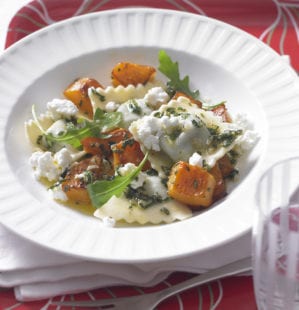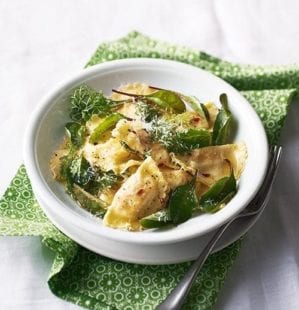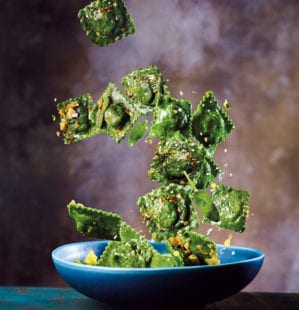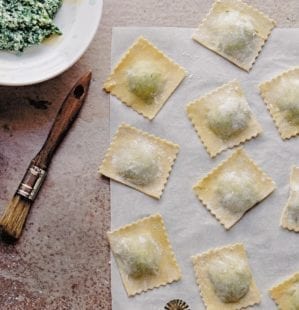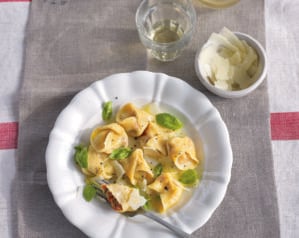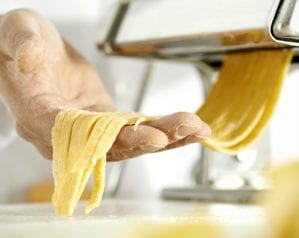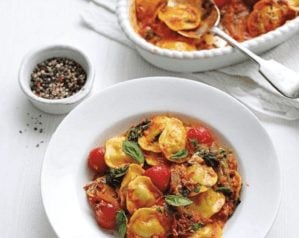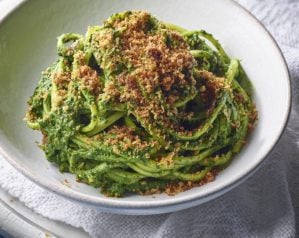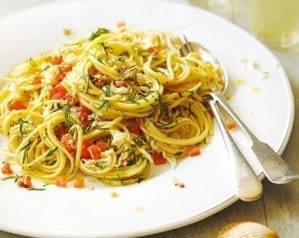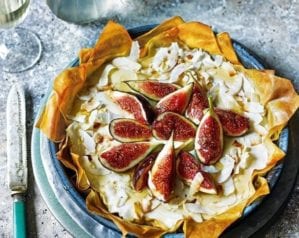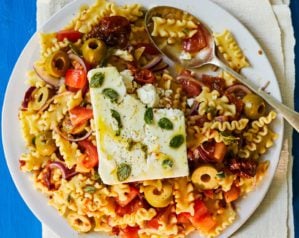
Crab and ricotta ravioli with sage and saffron butter sauce
- Published: 28 Jun 22
- Updated: 18 Mar 24
Have a go at making fresh ravioli with our project recipe. We’ll guide you through the pasta-making process step by step. Serve these elegant crab and ricotta ravioli with a saffron-flecked sage butter.
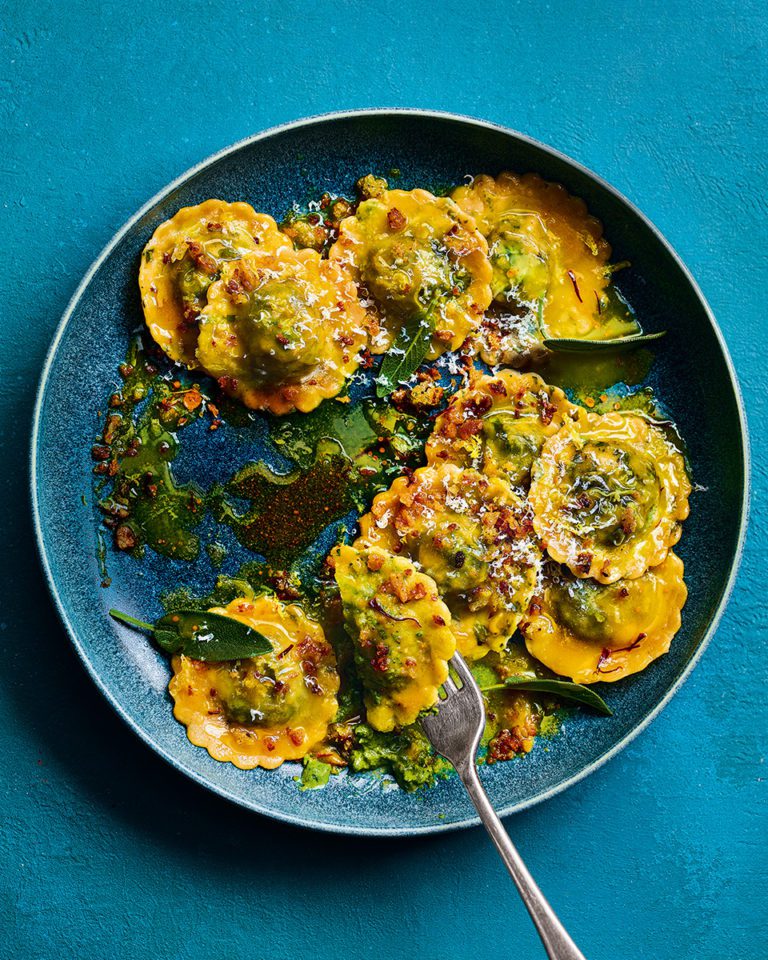
New to the homemade pasta game? Our gnocchi recipe is a good place to start.
-
Serves 4
-
Hands-on time 1 hour, plus resting. Simmering time 10 min
Ingredients
For the pasta dough
- 260g ‘00’ flour
- 5 large free-range egg yolks, plus 2 large whole free-range eggs, lightly beaten
- Extra flour to dust
For the ravioli filling
- 200g white crabmeat
- 250g ricotta
- 30g flatleaf parsley, finely chopped (reserve a small handful for the sauce)
- 15g basil, finely chopped
- Grated zest and juice 1 lemon (reserve half for the sauce)
- 1 garlic clove, crushed
For the sage and saffron butter sauce
- 100g butter
- 2 large or 4 regular slices sourdough bread, whizzed to breadcrumbs
- 1 garlic clove, crushed
- Pinch saffron
- 3 tbsp olive oil
- 20g sage leaves
- Parmesan, grated, to serve
You’ll also need
- 6.5cm fluted or smooth-edged cutter (but you can use a knife)
Method
- To make the pasta dough, sift the flour onto a clean work surface to form a mound. Make a large well in the centre using the base of the sieve.
- Add the beaten egg yolks and eggs to the well, then gradually incorporate the flour into the eggs with your fingers.
- Make circular stirring motions with your fingers shaped like a claw, bringing more of the flour into the centre of the mound as you stir in increasing circles.
- Keep pinching more flour into the dough with your fingers until the dough is moist but not sticky.
- When the dough has come together into a ball and has a smooth texture, it’s ready – you may not need all the flour.
- Knead for 5-10 minutes: push the pasta dough away from you with the heel of your hand, fold in half lengthways, then turn it 90 degrees and repeat until the dough is soft and stretchy. Cover with a damp tea towel and set aside for 20 minutes to relax.
- To make the filling, put all the filling ingredients in a bowl and mix well. Season generously with salt and pepper.
- To roll the pasta… Once the pasta dough has rested you can roll it out, either with a pasta machine or by hand. When using a pasta machine, it’s easier to cut the dough into quarters and run it through the machine piece by piece. Wrap the dough you’re not working with tightly in cling film to stop it from drying out.
- Set the pasta machine to its widest setting, then flatten and shape the piece of dough into a rectangle so it will fit widthways through the rollers. If the dough seems a little wet, flour it lightly. Carefully pass the dough through the rollers, then fold in half, end to end. Repeat two or three times, folding and passing the dough through the rollers each time. If the dough starts sticking, sprinkle the machine’s rollers and the work surface with a little extra flour.
- Once the dough has gone through the widest setting two or three times, narrow the setting by a notch. Continue to wind the pasta through, but this time don’t fold the dough in half. The dough will get longer and thinner each time.
- Carry on rolling the dough through, narrowing the rollers by a notch each time until the pasta is translucent and very long – for ravioli, as here, stop on the last but one setting.
- Repeat for each piece of dough, covering the finished sheets with clean, slightly damp tea towels until needed.
- To cut the ravioli shapes, cut the rolled dough sheets to roughly 50cm lengths. Working one sheet at a time (leave the others under the tea towels), cut out rounds in the dough using a 6.5cm fluted or smooth-edged cutter (you could also cut out squares using a sharp knife).
- Put teaspoonfuls of the filling in the centre of half the rounds. Lightly brush the pasta around the fillings with water. Cover with a second circle of pasta, then press gently around each mound of filling to push out any air and seal the dough.
- Put the ravioli, not touching each other, on a clean tea towel. Repeat with the rest of the dough (see Make Ahead).
- To make the sauce, divide the butter equally between 2 saucepans (one large, one small) and put them over a medium heat until melted. Add the breadcrumbs and garlic to the small pan, stir for 3-5 minutes until golden, then set aside.
- Meanwhile, put the saffron in the large pan of melted butter and fry for 2-4 minutes to crisp up and flavour the butter. Remove the pan from the heat, then stir in the olive oil, reserved parsley and reserved lemon zest and juice (from the filling).
- To cook the ravioli, ring a large pot of salted water to the boil. Cook the ravioli for 3-4 minutes, in batches (depending on the size of your pot – the pasta should have space to move around). Remove with a slotted spoon and keep warm. Repeat with the remaining pasta, adding the sage with the last batch. When cooked, remove the ravioli and sage.
- Stir half a cup of the pasta water into the saffron butter. Add all the ravioli and the sage to the saffron butter pan, toss gently to coat, then divide among serving bowls and top with the crispy breadcrumbs.
- Recipe from June 2022 Issue
Nutrition
- Calories
- 824kcals
- Fat
- 47.6g (21.7g saturated)
- Protein
- 33.6g
- Carbohydrates
- 63.5g (2.7g sugars)
- Fibre
- 3.8g
- Salt
- 1.4g
delicious. tips
Easy swaps: Feel free to play with the filling – parma ham or smoked salmon instead of the crab would work a treat. Don’t like saffron? Leave it out and add the sage leaves straight to the butter instead.
Make the pasta dough up to 1 day ahead. Wrap well to prevent it drying out, then chill. Bring back to room temperature (at least 1-2 hours) before rolling. You can also freeze the dough in an airtight container for up to 3 months. Defrost overnight at room temperature before rolling and shaping as per the recipe.
You can make the ravioli shapes in advance. Leave to dry for 3-4 hours on the tea towel, turning over every so often, and open freeze on a baking tray, not letting the ravioli edges touch each other, until hard (about 30 minutes). You can then transfer the pasta to a labelled freezer bag and store in the freezer for up to 2 months. Cook from frozen in boiling salted water as with regular filled fresh pasta, but add 1-2 minutes to the cooking time once the water returns to the boil.
You can make the dough in a stand mixer fitted with a dough hook if you prefer. Sift the flour into the bowl, pour the yolks and whole eggs into the flour, then mix until a dough forms. Knead for 5-10 minutes to a soft dough.
Buy ingredients online
Rate & review
Rate
Reviews
Subscribe to our magazine
Food stories, skills and tested recipes, straight to your door... Enjoy 5 issues for just £5 with our special introductory offer.
Subscribe
Unleash your inner chef
Looking for inspiration? Receive the latest recipes with our newsletter

